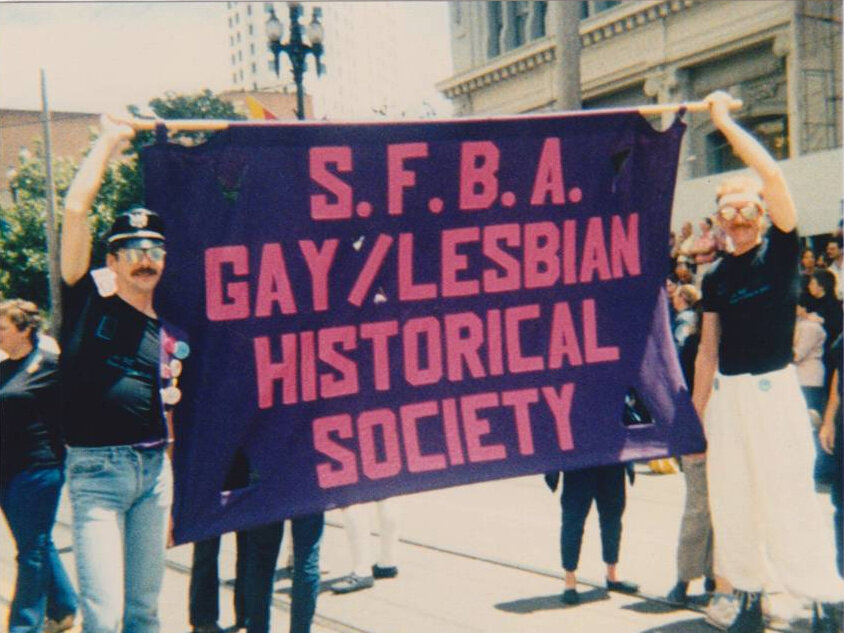Reflections on Our 35th Anniversary
The GLBT Historical Society contingent in the 1985 San Francisco International Lesbian & Gay Freedom Day Parade; photograph by Sandy Morris, courtesy same.
“The GLBT Historical Society’s History is One of Activism”: Reflections on Our 35th Anniversary
by Diana Wakimoto & Mark Sawchuk
The GLBT Historical Society, then known as the San Francisco Bay Area Gay and Lesbian Historical Society, was founded 35 years ago in March 1985. With over three decades of archival collecting, community outreach, exhibitions and programming, the society, were it a person, would be approaching middle age — a development that’s reflected in the fact that our archivists have begun processing our own organizational records.
A major birthday is always an opportunity for some self-reflection. To help us take stock of where we are and where we’ve been, we have enlisted the support of Diana Wakimoto (pictured), a librarian at Cal State East Bay. She performed research on the GLBT Historical Society’s history for a 2013 article she coauthored, “Archivist as Activist: Lessons From Three Queer Community Archives in California,” which appeared in the peer-reviewed journal Archival Science. History Happens interviewed Wakimoto for a fresh perspective on the society’s history and to celebrate this special anniversary.
In your article “Archivist as Activist,” you argue that “community archives are the embodiment of activism in the archives.” How has this archival activism been manifest in the society’s history?
DW: From its founding as a periodical collection to its present form as an archives and museum, the GLBT Historical Society’s history is one of activism. As one of its founders, Willie Walker, noted and those I interviewed for my article reiterated, if community members 35 years ago hadn’t saved their records, no one would have. Institutional archives such as those attached to universities were not collecting LGBTQ-related materials; there truly was a silencing. This activism remains through the society’s continued commitment to documenting not only the famous and powerful, but the ordinary, too.
You also note that the GLBT Historical Society is unusual because it “has always functioned as more than a traditional archives, serving also as a meeting space and museum.” How has that set it apart?
DW: Community archives, in general, often function as more than traditional archives and include programming, meeting spaces and exhibitions. But what sets the society apart is that it was established from the beginning as a historical society to appeal to many interests and groups. Historical societies function as more than archives; they are important gathering places and showcase history through programming and exhibitions. The organization keeps this tradition alive. Its commitment to the working group model sets it apart and, of course, having a free-standing museum is unique and provides increased visibility and opportunities for outreach.
How has the society worked to live up to its longstanding commitment to collect materials documenting the full range of diversity in the LGBTQ community?
DW: While diversity, equity, and inclusion have become buzzwords in academia over the last few years, the GLBT Historical Society has documented the full range of diversity in the LBGTQ community since its earliest days. There’s always been a commitment to collecting in the “gaps and margins,” even though this is difficult, and the collection development policy has reflected that. The fact that the society is deeply connected through its working groups, community curators and sustained presence demonstrates that it is a trustworthy repository for materials documenting all members of the community
Taking into account both the GLBT Historical Society’s past history and the growing international interest in queer archives and collecting institutions, what do you envision the society’s role to be in the future?
DW: I would never claim to have a crystal ball, but I hope that the society continues to grow and diversify its collections and its ability to connect with Bay Area communities and beyond. I hope that it continues to find balance among its programs, exhibitions and collections, as the three support each other. I can see the organization serving as a model for other community-based archives, by demonstrating how to maintain community involvement, secure funding, and remain true to the mission and values of the founders while also adapting and growing. I look forward to seeing what the next 35 years hold; the society truly is an amazing embodiment of archival activism.
Diana Wakimoto, Ph.D. is a librarian at Cal State East Bay, with research interests in archival experience, graphic design, and technology in teaching and learning.
Mark Sawchuk is the society’s communications manager.



